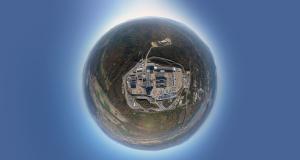What it takes to light a star
Ten years ago, in the summer of 2010, construction work began on one of the largest international science projects in the world. ITER is first and foremost about science. It is about observing and understanding the physics of a burning plasma—a state of matter that exists only in the core of the stars. But in order to create burning plasmas inside a tokamak and harness a new energy source for the generations to come, a massive industrial infrastructure is required.
This latest drone survey, from November 2020, lets you take in the size and complexity of the ITER installation. From the electrical switchyard that could power a city of one million to the kilometres of "busbars" that feed the magnetic system ... from the single-platform cryoplant that manages and distributes the cooling fluids to the industrial facility where giant superconducting ring coils are manufactured ... and from the oversized heat rejection system capable of dissipating a power load of 1,000 megawatts to the Holy of Holies of the machine assembly pit, ITER appears as what it is—a unique place where human intelligence and ingenuity, with the help of the most sophisticated technologies, is rising to the challenge of one of our civilization's most daunting problems.
Watch the 5-minute video here.


